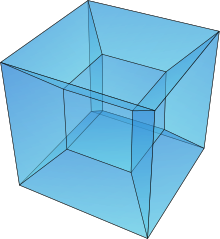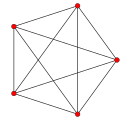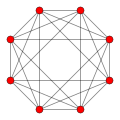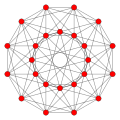Regular 4-polytope

In mathematics, a regular 4-polytope is a regular four-dimensional polytope. They are the four-dimensional analogues of the regular polyhedra in three dimensions and the regular polygons in two dimensions.
There are six convex and ten star regular 4-polytopes, giving a total of sixteen.
History[]
The convex regular 4-polytopes were first described by the Swiss mathematician Ludwig Schläfli in the mid-19th century.[1] He discovered that there are precisely six such figures.
Schläfli also found four of the regular star 4-polytopes: the grand 120-cell, great stellated 120-cell, grand 600-cell, and great grand stellated 120-cell. He skipped the remaining six because he would not allow forms that failed the Euler characteristic on cells or vertex figures (for zero-hole tori: F − E + V = 2). That excludes cells and vertex figures such as the great dodecahedron {5,5/2} and small stellated dodecahedron { 5/2,5}.
Edmund Hess (1843–1903) published the complete list in his 1883 German book Einleitung in die Lehre von der Kugelteilung mit besonderer Berücksichtigung ihrer Anwendung auf die Theorie der Gleichflächigen und der gleicheckigen Polyeder.
Construction[]
The existence of a regular 4-polytope is constrained by the existence of the regular polyhedra which form its cells and a dihedral angle constraint
to ensure that the cells meet to form a closed 3-surface.
The six convex and ten star polytopes described are the only solutions to these constraints.
There are four nonconvex Schläfli symbols {p,q,r} that have valid cells {p,q} and vertex figures {q,r}, and pass the dihedral test, but fail to produce finite figures: {3,5/2,3}, {4,3,5/2}, { 5/2,3,4}, { 5/2,3,5/2}.
Regular convex 4-polytopes[]
The regular convex 4-polytopes are the four-dimensional analogues of the Platonic solids in three dimensions and the convex regular polygons in two dimensions.
Five of the six are clearly analogues of the five corresponding Platonic solids. The sixth, the 24-cell, has no regular analogue in three dimensions. However, there exists a pair of irregular solids, the cuboctahedron and its dual the rhombic dodecahedron, which are partial analogues to the 24-cell (in complementary ways). Together they can be seen as the three-dimensional analogue of the 24-cell.
Each convex regular 4-polytope is bounded by a set of 3-dimensional cells which are all Platonic solids of the same type and size. These are fitted together along their respective faces (face-to-face) in a regular fashion.
Properties[]
Like their 3-dimensional analogues, the convex regular 4-polytopes can be naturally ordered by size as a measure of 4-dimensional content (hypervolume) for the same radius. Each greater polytope in the sequence is rounder than its predecessor, enclosing more content[2] within the same radius. The 4-simplex (5-cell) is the limit smallest case, and the 120-cell is the largest. Complexity (as measured by comparing configuration matrices or simply the number of vertices) follows the same ordering.
| Regular convex 4-polytopes | |||||||
|---|---|---|---|---|---|---|---|
| Symmetry group | A4 | B4 | F4 | H4 | |||
| Name | 5-cell Hyper-tetrahedron |
16-cell Hyper-octahedron |
8-cell Hyper-cube |
24-cell
|
600-cell Hyper-icosahedron |
120-cell Hyper-dodecahedron | |
| Schläfli symbol | {3, 3, 3} | {3, 3, 4} | {4, 3, 3} | {3, 4, 3} | {3, 3, 5} | {5, 3, 3} | |
| Coxeter mirrors | |||||||
| Graph | 
|

|

|

|

|

| |
| Vertices | 5 | 8 | 16 | 24 | 120 | 600 | |
| Edges | 10 | 24 | 32 | 96 | 720 | 1200 | |
| Faces | 10 triangles | 32 triangles | 24 squares | 96 triangles | 1200 triangles | 720 pentagons | |
| Cells | 5 tetrahedra | 16 tetrahedra | 8 cubes | 24 octahedra | 600 tetrahedra | 120 dodecahedra | |
| Tori | 1 5-tetrahedron | 2 8-tetrahedron | 2 4-cube | 4 6-octahedron | 20 30-tetrahedron | 12 10-dodecahedron | |
| Inscribed | 120 in 120-cell | 1 16-cell | 2 16-cells | 3 8-cells | 5 24-cells x 5 | 5 600-cells x 2 | |
| Great polygons | 2 | ||||||


